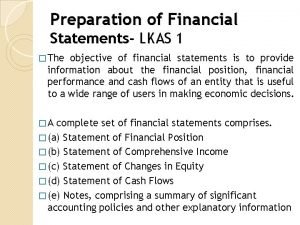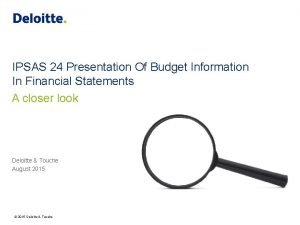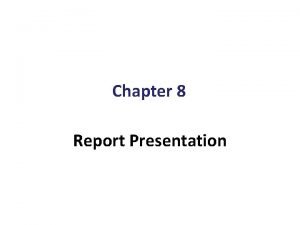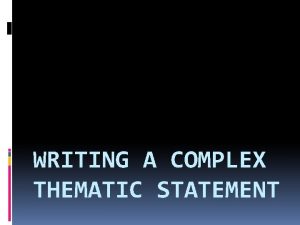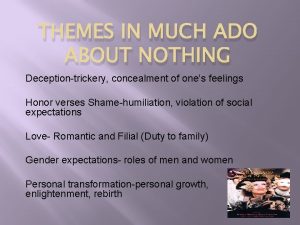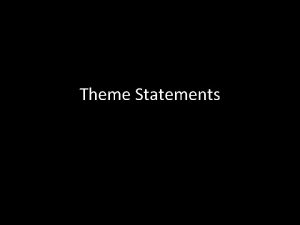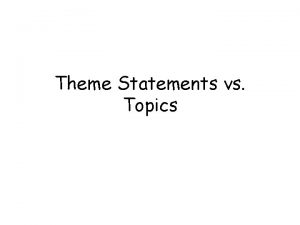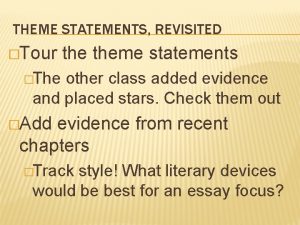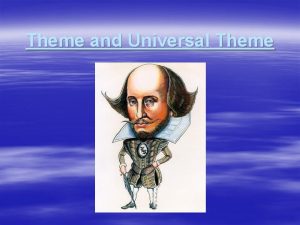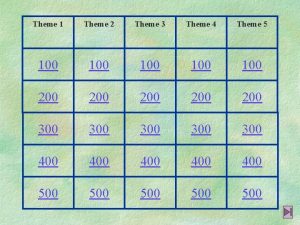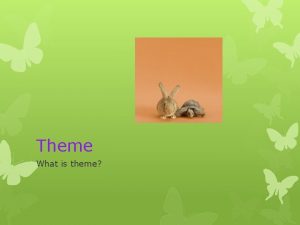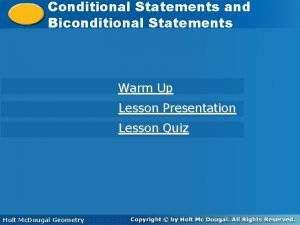A Successful Presentation Understanding theme theme statements and












- Slides: 12

A Successful Presentation Understanding theme, theme statements, and MLA citation basics

LITERARY TERMS REVIEW: v v v The words on the crossword puzzle should be review. We will be using these literary terms throughout our semester together to discuss the literature that we read in class. We’ll also be adding new definitions. Keep in mind when recording definitions that wording does not matter. Instead, it is more important for you to understand how a literary term is used. You will need to decide what is most important to remember as you take your notes. Use clues to help you figure out what is most important. Clues might include: – Bold-face font, underlining, italics, and repeated information or phrasing

Theme What exactly is this elusive thing called theme? The theme of a fable is its moral. The theme of a parable is its teaching. The theme of a piece of fiction is its view about life and how people behave. Essentially, a theme is a comment on humanity, reality, and perhaps society. In fiction, theme is not intended to teach or preach. In fact, it is not presented directly at all. You extract it from the characters, action, and setting that make up the story. In other words, you must figure out theme yourself. The writer's task is to communicate on a common ground with the reader. Although the particulars of your experience may be different from the details of the story, the general underlying truths behind the story may be just the connection that both you and the writer are seeking.

Definition v Theme – the central insight or truth regarding human experience that is expressed through the fictional world that the writer creates.

Keep this in mind… v v Themes are generally implied rather than directly stated. Themes are not directives; they do not direct the reader to do or not do something. – Example - • Not a theme: People should not judge each other based on stereotypes. • Theme: All people unconsciously use stereotypes to prejudge members of particular groups. v v v The theme is not the plot; however, a statement of theme often emerges from the central conflict of the story. Themes are declarative sentences that relate the specifics of a story to the human experience. Themes are not single concepts or one word abstract ideas – Example • Not a theme: Heroism • Theme: Devotion to an ideal can make a simple life heroic.

Finding the Theme v Here are some ways to uncover theme in a story: – Check out the title because sometimes it tells you about theme. – Notice repeating patterns and symbols as they may lead you to a theme. – What are the details and particulars in the story? What greater meaning may they have? – Remember that theme, plot, and structure are inseparable, all helping to inform and reflect back on each other. Also, be aware that a theme we determine from a story never completely explains the story. It is simply one of the elements that make up the whole. – A story may have more than one theme.

How will you use this information? v You and your group will use this information about theme statements to complete your summer reading choice project. v Be sure to test your group’s theme statement against the four bullets on the top of the “Brainstorming” page in your packet.

Thematic ideas: To help you get started thinking about themes, consider these thematic ideas. Understanding one’s identity The role of culture in identity formation v Recreation of the self Loyalty to family The power of the individual How individuals act vs. group mentality Responsibility to others How might you write one of these thematic ideas as a theme statement?

MLA Information v v You will also need to be sure to cite the quotations and paraphrases from your text. This means that you will need parenthetical citations at the end of each of your examples and a works cited page on the back of your poster. This should be your MLA Made Simple guide. You will find the information for creating your works cited page. You will use this page often, so you may want to bookmark it or dog-ear the page.

Works Cited v v v For a book entry, you will need the following: Author’s last name, first name. Title of the book. Place of Publication: Publisher, copyright. Print. Woolf, Virginia. A Room of One's Own. New York: A Harvest/ HBJ Book, 1957. Print. Notice that you no longer underline the title. It is italicized. And, you now have to add what type of source you have used – print, web, performance, etc.

Parenthetical Citations The Basics: v Anytime you use a direct quotation or paraphrase an idea, fact, statistic, date, or definition from another source, you must list it in your Works Cited and insert a parenthetical citation at the end of the sentence. v The author’s last name and page number appear in parentheses. If an author is not listed, you use whatever comes next in the works cited entry inside your parentheses (this is usually the “Article Title”). If you mention author’s name in the sentence you are citing, you only need the page number in parentheses. v No punctuation is inserted between name and page number. v No abbreviation (p. ) or word (page) is included to identify the number as a page number. Example: “But the boy knew only unhappiness as he wandered about the shrine exhausted” (Mishima 122 ). – NOTICE • Place the parenthetical citation directly after the quotation marks. • End the sentence with a period.

Thematic Idea (include images that illustrate your theme and not images from the book). Explanation of how a literary device applies to your theme. Theme statement What details from the text support your theme statement? Create a list of at least four quotations and/or examples to support your theme. Be sure to include page numbers. Example one (page). Example three (page). Example two (page). Example four (page).
 Lkas 01
Lkas 01 Presentation of budget information in financial statements
Presentation of budget information in financial statements Aasb 8
Aasb 8 Fetal lie
Fetal lie Cephalic presentation
Cephalic presentation Complex theme statement
Complex theme statement Thesis of things fall apart
Thesis of things fall apart Thematic statement for love
Thematic statement for love Allusions in much ado about nothing
Allusions in much ado about nothing What is a thematic statement?
What is a thematic statement? What are theme statements
What are theme statements Macbeth quotes
Macbeth quotes Examples of jealousy in literature
Examples of jealousy in literature
